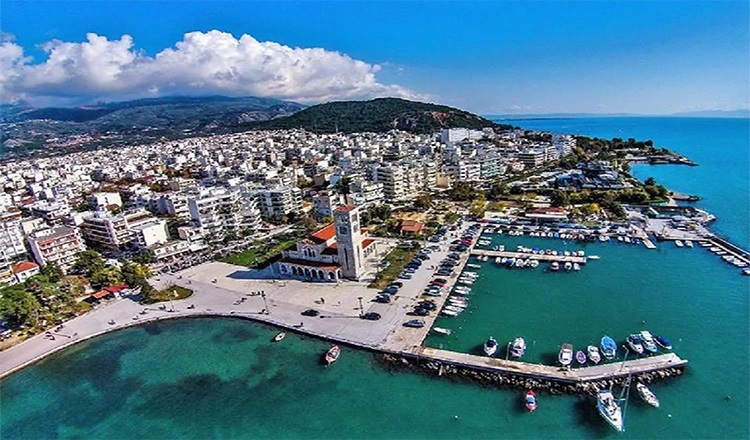
Volos
Volos is one of the largest cities in Thessaly and the capital of the Magnesia region. It is a big, dynamic, and modern city. It is bathed by the Pagasetic Gulf and shaded by the beautiful Pelion with its picturesque villages. It is built at the foot of Mount Pelion and is located in the center of Greece, between the capital Athens and Thessaloniki.
History of Volos
The first thing we learned about Volos, also known as ancient Iolcus, is related to the mythical hero Jason, the Golden Fleece, and the Argonautic expedition. Jason, in order to retrieve the Golden Fleece from distant Colchis, constructed the ship "Argo" from the unique woods of Mount Pelion, under the guidance of the goddess Athena. In the area of Volos, archaeological excavations have revealed more than 40 Neolithic settlements from the 8th-7th millennium BCE.
In 1423, the Castle of Palaios (Old) Volos was occupied by the Turks, and all the economic and cultural activity of the region was transferred to Pelion, where it received privileges from the Ottomans. During the 18th century, Pelion developed into one of the most important industrial and cultural centers in the Greek territory. With the onset of the Greek Revolution in 1821, the villagers of Pelion revolted. In 1881, after the Treaty of Constantinople, Volos and the region of Magnesia were annexed to the newly formed Greek state.
Subsequently, Volos experienced significant population and commercial growth. The development of both the railway and port facilities contributed to the establishment of numerous industries. However, equally important was the cultural and social flourishing that occurred simultaneously. The city of Volos, like the rest of Greece, suffered damages during World War II. Many refugees from Asia Minor, who had arrived in the city in 1922, as well as refugees from other Thessalian villages, settled in Volos, creating a new settlement in the Xirokampos area known as Nea Ionia. The earthquakes of 1955 had a significant impact on the city. However, the city quickly recovered and continued to develop.
Today, Volos is an important tourist destination with beautiful beaches, landmarks, and a rich history. The combination of traditional architecture with modern infrastructure, as well as the variety of activities it offers, makes Volos a popular destination for tourists from around the world.
Beaches in Volos
From Pelion, visitors have the opportunity to discover some of the most beautiful beaches in Greece, located either in the Pagasetic Gulf or in the vast blue of the Aegean Sea.
- Mylopotamos: After crossing the forested path following the famous Tsagarada of Pelion and descending towards the sea, you will reach Mylopotamos. It is perhaps the most famous beach in the area, with warm waters that last until autumn. The impressive rock sculpted by the power of the sea and the wind constitutes a true natural monument.
- Damouchari: In close proximity to Tsagarada is the beach of Damouchari, a small corner with white and pink pebbles. The waves embrace the shore and create unique sounds as they interact with the pebbles, almost like a song. This beach has even been used for filming scenes in the famous American movie "Mamma Mia!".
- Chorefto Beach: It is one of the most beautiful and longest beaches in all of Greece, with a captivating coastline stretching for 2.5 kilometers. The route from Zagora to Chorefto is magnificent, combining the mountain with the sea. Chorefto got its name from the waves that appear to dance along the shore.
If someone wishes to visit "secret" beaches, they can discover Parisaina, Analipsi, and Agioi Saranta. All these beaches are located very close to Chorefto and offer a unique experience to visitors.
Sights in Volos
- Park of Agios Konstantinos: The park named Agios Konstantinos Park was created in 1920 according to the plans of architect N. Kitsikis. It is located on the beach of Volos and was formerly known as Georgiou A Square.
- Achillion: The Achillion cinema-theater was built in 1925 and continues to operate to this day.
- Municipal Conservatory: The neoclassical building of the Municipal Conservatory was established around 1885 and from 1900 onwards, it operated as the National Bank of Greece.
- Giorgio De Chirico Art Center: The Giorgio De Chirico Art Center is located next to the Municipal Conservatory and houses the Alekos K. Damtsas Museum. The museum hosts periodic exhibitions of visual artworks and has a permanent collection.
- Anavros Park: Anavros Park includes modern sculptures by Greek and foreign artists.
- Volos Castle: Volos Castle is located in the old neighborhood in the western part of the city. It was built in the mid-6th century BCE, and in the underground garage of the multipurpose venue Village, you can admire the Roman Baths.
- Panthessaliko Stadium: The modern Panthessaliko Stadium was constructed for the 2004 Olympic Games.
- Goritsa Hill: Goritsa Hill is located east of the city of Volos and is a natural elevation of about 200 meters above sea level. At the hill's summit, you can find the Church of Zoodochos Pigi. From there, you can enjoy a panoramic view of the city and the port of Volos.
- Pelion Train: The famous Pelion Train, also known as "Moutzouris," is a steam-powered train that has been operating for approximately 70 years. A ride on the train will enchant you as you enjoy a spectacular journey that rewards your choice.
